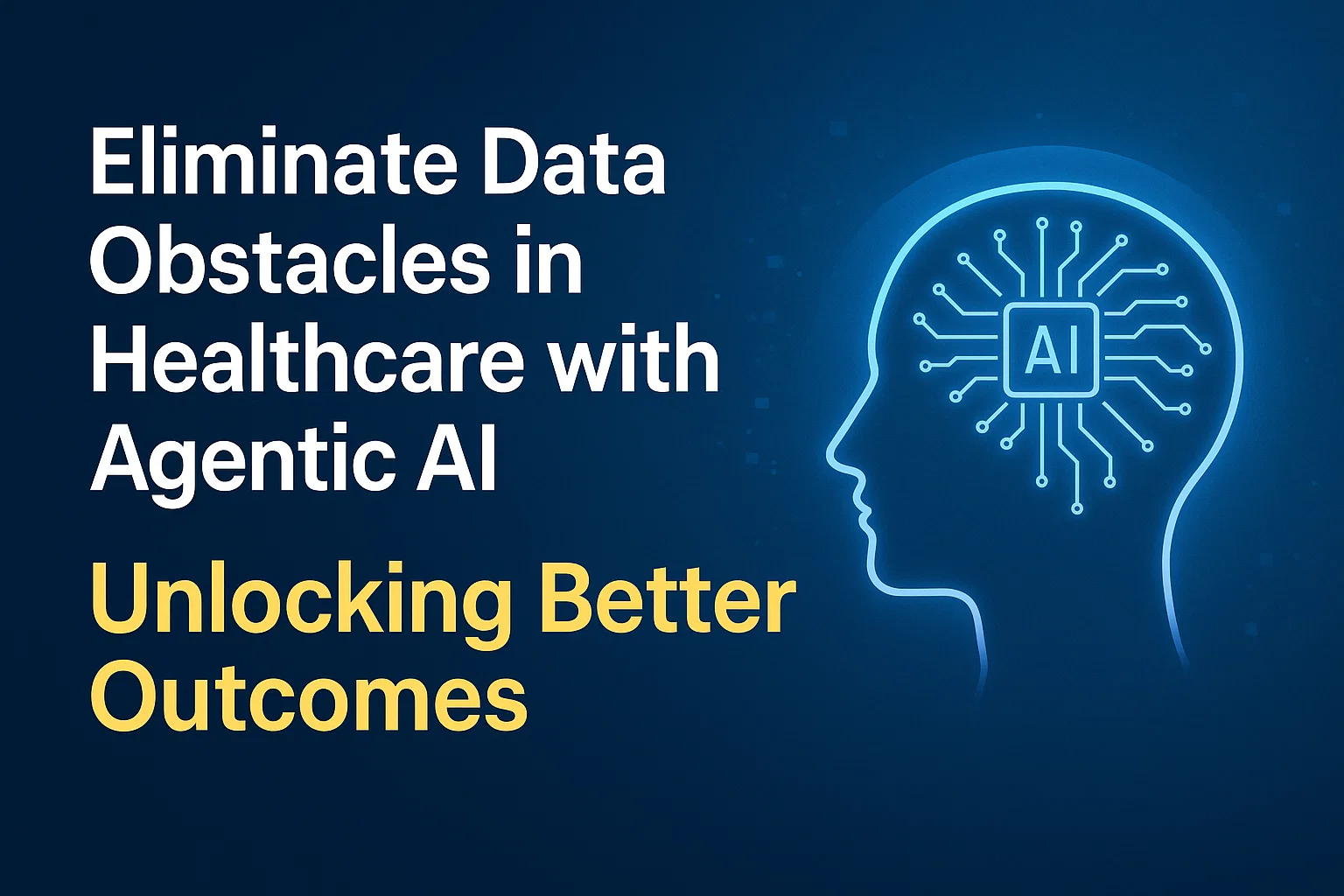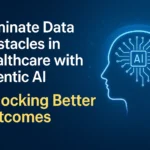
- June 13, 2025
- 1. Eliminate Data Obstacles in Healthcare with Agentic AI: Unlocking Better Outcomes
- 1.1. Data Obstacles in Healthcare
- 1.2. Introducing Agentic AI for Data Engineering in Healthcare
- 1.3. Breaking Down Data Silos with Agentic AI
- 1.4. Optimizing Data Pipelines for Reliable, Actionable Insights
- 1.5. The Benefits of Agentic AI in Healthcare Data Management
- 1.6. Real-World Applications and Use Cases of Agentic AI in Healthcare
- 1.7. Overcoming Implementation Challenges
- 1.8. Future Trends: The Evolving Role of Agentic AI in Healthcare
- 1.9. Conclusion
- 1.10. When you work with Visvero, you get:
- 2. FAQs
- 2.1. What are the biggest data obstacles in healthcare today?
- 2.2. How does Agentic AI help break down data silos in healthcare?
- 2.3. What are the benefits of implementing Agentic AI in healthcare data engineering?
- 2.4. What challenges should healthcare leaders consider before adopting Agentic AI?
- 2.5. How can healthcare organizations get started with Agentic AI?
1. Eliminate Data Obstacles in Healthcare with Agentic AI: Unlocking Better Outcomes
Hospitals, clinics, and care centers are generating massive amounts of data that include patient records, lab results, imaging, and billing systems. Yet that data often remains locked in silos. In fact, nearly 30% of global data volume comes from healthcare, and by the end of 2025, its annual growth is projected to top 36%. Despite this exponential increase, fragmented systems and legacy platforms still hamper the ability to turn raw data into real insights.
So, how often does a physician have to switch systems just to get a full picture of a patient? Or how frequently do administrative teams lose hours hunting for lab results spread across disconnected databases? These aren’t just process gaps but missed opportunities and diminished patient trust.
Agentic AI provides a smart layer joining broken sources, automating data harmonization, and delivering the correct information to the correct clinician at the right time. It offers healthcare leaders an opportunity to make complexity clear, increase efficiency, enhance data governance, and, in the end, better patient outcomes.
1.1. Data Obstacles in Healthcare
The best data-laden healthcare systems have difficulty turning actionable insights, not just any insights, but clean, reliable, and relatively free-from-churnable insights, when they are supported by a fractured infrastructure. Much of the infrastructure has its roots in legacy platforms designed more for billing and record-keeping than for modern data operations. Oftentimes, these systems lack the ability to scale with the velocity demands of real-time clinician, analyst, or operations needs.
Data silos remain a core issue. Clinical data lives in one system. Financial data in another. Operational data elsewhere still. This fragmentation leads to duplicated work, gaps in visibility, and misaligned decision-making, especially in environments where things go fast, such as in acute care or even revenue cycle operations.
Where integration exists, it’s often stitched together manually or built on brittle pipelines prone to latency and error. As a result, decision-makers are left working with delayed or partial views of performance, patient needs, or resource demands. That directly impacts outcomes and efficiency.
Healthcare organizations need infrastructure designed to orchestrate data across teams, systems, and timeframes, without dragging technical teams into constant troubleshooting.
1.2. Introducing Agentic AI for Data Engineering in Healthcare
Agentic AI is a next-generation approach to healthcare data engineering, purpose-built to automate and streamline the movement, harmonization, and usability of data across clinical and operational systems. It does not function as a surface-level analytics tool or another dashboard layer. Instead, it addresses data challenges at the structural and engineering level, where they actually begin.
The complexity and scale of data are especially demanding in healthcare. Systems must interpret and organize information in ways that are timely, reliable, and meaningful to users.
Agentic AI’s adaptive agent-based framework uses intelligent agents to automate everything from pipeline orchestration to schema alignment across EHRs, labs, imaging repositories, and financial systems. These agents can detect inconsistencies and route data intelligently in real time. This reduces lag and manual rework.
Some common features include:
- Autonomous pipeline construction: Intelligent agents analyze system dependencies and build stable data flows with minimal setup.
- Schema-aware harmonization: Automatically aligns and transforms disparate data structures into a coherent model.
- Real-time system monitoring: Flags inconsistencies, latency, or failures before they impact downstream users.
- Minimal human intervention: Built to reduce engineering burden, not add to it.
Agentic AI use in healthcare organizations makes their data usable across the entire organization.
1.3. Breaking Down Data Silos with Agentic AI
In most healthcare organizations, data is trapped in departmental systems that were never designed to work together. Patient records may sit in an EHR, diagnostics in a PACS, billing in a finance platform, and care plans in a third-party tool, each operating in isolation. These silos make it difficult to deliver timely, coordinated care.
Agentic AI tackles this fragmentation by serving as an intelligent data bridge across the ecosystem. Its agent-based architecture actively scans, interprets, and aligns data structures in real time, regardless of system origin or format. The AI used in healthcare creates a shared layer of structured, context-aware information that is ready to serve clinical and operational needs by harmonizing these disparate sources
Real-time integration ensures that new information flows immediately into downstream systems without delay or degradation. Instead of relying on batch updates or custom scripts, healthcare teams gain live, interoperable access to the data that matters most.
With data unified and ready to move across domains, cross-functional collaboration becomes more actionable. Clinical teams can make decisions based on the full patient context. Finance teams can match care delivery with billing and reimbursement data. Informatics teams can draw insights without chasing CSVs or wrangling APIs.
1.4. Optimizing Data Pipelines for Reliable, Actionable Insights
Healthcare data pipelines are only as strong as their weakest link. When systems rely on outdated middleware, manual transfers, or rigid ETL processes, the result is often inconsistent data flow, delayed reporting, and limited confidence in what the numbers actually represent. These issues slow down decisions and compromise outcomes.
Agentic AI strengthens these pipelines at their foundation. Its autonomous agents watch data quality as it goes, looking for completeness, consistency, and contextual rightness. Instead of leaning on human help to find errors after they happen, the system notes oddities in real time, helping teams fix issues before they spread across work.
Agentic AI cuts down on manual touchpoints that often lead to copying, leaving out, or wrong placing by automating these steps. This not only reduces human error but also supports stronger governance by enforcing validation standards as data travels between systems.
This means dashboards that reflect current realities, not last week’s records or mismatched codes. For operations teams, it translates into more precise forecasts, faster approvals, and better alignment across departments. And for analysts, it opens the door to deeper insights with less time spent cleaning or reconciling input.
Agentic AI changes the data pipeline into a dependable channel where information flows smoothly, reliably, and with a level of quality that decision-makers can trust.
1.5. The Benefits of Agentic AI in Healthcare Data Management
Agentic AI allows clinical teams to access a more complete and coherent picture of patient health. Rather than managing siloed data and chasing after piecemeal narratives, providers receive consolidated intelligence, organized and onboard to support decisions. This translates into quicker diagnostics, treatments that are personal to the patient, and standardization of care across teams and facilities.
The other beneficiaries are operational leaders who receive help in the form of automation that reduces tedious manual steps. With cleaner inputs and fewer system handoffs, administrative workflows become leaner, approvals move faster, and routine reporting demands less effort. Agentic AI supports cost reduction not through broad cuts, but through precision: fewer redundancies, clearer KPIs, and fewer delays.
Finally, for patients, the experience improves in ways that are both visible and behind the scenes. Coordinated communication between departments, shorter wait times, and more accurate treatments all begin with smarter data infrastructure. With Agentic artificial intelligence in healthcare, organizations are better equipped to serve individuals, not just through innovation, but through integration that actually works.
1.6. Real-World Applications and Use Cases of Agentic AI in Healthcare
Agentic AI is already reshaping how data-driven healthcare operates across departments and disciplines.
Agentic AI equips analysts and care teams in population health management with timely, high-fidelity data to identify at-risk groups, track outcomes across demographics, and enable more proactive interventions. Predictive models become more accurate when built on structured, harmonized information pulled directly from fragmented inputs.
Financial and revenue cycle operations also gain stability. With Agentic AI, billing codes, insurance data, and patient financial interactions are streamlined into a coherent flow. That reduces errors, improves reimbursement timelines, and gives finance teams clearer visibility into performance across payers and services.
On the clinical front, decision support systems are more effective when fed by reliable and context-rich data. Agentic AI enables this by refining data pipelines behind imaging systems and EHRs, helping clinicians diagnose with confidence and intervene earlier. Even in complex scenarios such as radiology or pathology, the AI framework enhances system responsiveness without disrupting workflows.
Finally, interoperability is no longer aspirational. Agentic AI bridges legacy systems in healthcare and modern EHR systems, providing seamless handoffs that reduce rework and eliminate gaps. It supports forward-thinking IT strategy while preserving investments in existing infrastructure, a capability most vendors fail to deliver.
1.7. Overcoming Implementation Challenges
Deploying a new data framework in healthcare is never just a technical task. It’s a cultural and regulatory shift. Agentic AI addresses with design decisions tailored to the realities of clinical and operational environments.
Data privacy and compliance sit at the foundation. Agentic AI is built with healthcare-grade security architecture, enabling organizations to remain aligned with regulations such as HIPAA without relying on workarounds. Role-based access, audit trails, and secure integrations ensure that sensitive information is handled appropriately at every step of the pipeline.
Change management is another concern, and a valid one. Healthcare teams operate under tight schedules and high stakes. Rolling out new tools often faces pushback not due to unwillingness, but uncertainty. Agentic AI mitigates this by integrating into existing environments with minimal disruption. Its no-code and low-code interfaces make adoption easier across roles, from data engineers to clinical informaticists.
The implementation strategy emphasizes phased rollouts, stakeholder alignment, and measurable wins to ensure scaling is sustainable. Organizations that begin with focused use cases, like automating intake data or standardizing lab results, see immediate value, which builds internal momentum for broader expansion.
1.8. Future Trends: The Evolving Role of Agentic AI in Healthcare
Healthcare is shifting toward intelligence-led operations, and Agentic AI is positioned to guide that transition with clarity and scalability. As next-generation AI models evolve, the demands on data infrastructure will increase. Precision, context-awareness, and adaptability will become baseline requirements. Agentic AI is engineered not only to meet these demands but to grow with them.
What follows is a healthcare environment where information assets do not reside in vacuums. With smooth interoperability, clinical, financial, and operational systems will inform one another in real time, fueling decisions that are faster, more accurate, and responsive to patient needs. Agentic AI plays a critical role in this trajectory by creating infrastructure that adapts to real-world conditions rather than imposing rigid models.
Its adaptive logic, real-time harmonization, and cross-domain integration make Agentic AI more than a short-term solution; it’s a foundation for continuous, intelligence-driven improvement. As care models shift toward personalization and predictive support, systems built with Agentic AI will already be equipped to support those demands, quietly, reliably, and with minimal intervention.
1.9. Conclusion
Healthcare’s future depends on how effectively organizations manage, move, and make meaning of their data. With rising demands for real-time insights, clinical precision, and system-wide coordination, traditional data architectures are no longer adequate.
Agentic AI stands out as a purpose-built solution for these realities. But behind every intelligent system is a partner who understands both the technology and the industry it’s built to serve.
For 20+ years, has helped data-driven organizations across healthcare, finance, energy, and more turn complex information landscapes into clear, outcome-oriented strategies. We pair real-world expertise with engineered solutions that perform when and where it counts.
1.10. When you work with Visvero, you get:
- AI-enabled systems designed for clarity, speed, and scale
- Strategic partnerships with Big 4 veterans and success practitioners
- Trusted delivery, with enterprise results and on-time execution
Your next chapter in healthcare innovation starts with smarter data—and a smarter data partner.
Connect with Visvero.Where data meets direction.
2. FAQs
2.1. What are the biggest data obstacles in healthcare today?
Siloed data, outdated legacy systems, and poor data pipelines that hinder accurate, real-time insights.
2.2. How does Agentic AI help break down data silos in healthcare?
It intelligently integrates and harmonizes fragmented data sources, creating a unified ecosystem for faster, data-driven decisions.
2.3. What are the benefits of implementing Agentic AI in healthcare data engineering?
Enhanced clinical decision-making reduced operational inefficiencies, improved patient outcomes, and data-driven cost savings.
2.4. What challenges should healthcare leaders consider before adopting Agentic AI?
Data security, regulatory compliance (like HIPAA), managing cultural shifts, and ensuring seamless system integration.
2.5. How can healthcare organizations get started with Agentic AI?
Assess current data infrastructure, partner with AI and healthcare data engineering experts, pilot small projects for quick wins, and build a roadmap for long-term transformation.
- 1. Eliminate Data Obstacles in Healthcare with Agentic AI: Unlocking Better Outcomes
- 1.1. Data Obstacles in Healthcare
- 1.2. Introducing Agentic AI for Data Engineering in Healthcare
- 1.3. Breaking Down Data Silos with Agentic AI
- 1.4. Optimizing Data Pipelines for Reliable, Actionable Insights
- 1.5. The Benefits of Agentic AI in Healthcare Data Management
- 1.6. Real-World Applications and Use Cases of Agentic AI in Healthcare
- 1.7. Overcoming Implementation Challenges
- 1.8. Future Trends: The Evolving Role of Agentic AI in Healthcare
- 1.9. Conclusion
- 1.10. When you work with Visvero, you get:
- 2. FAQs
- 2.1. What are the biggest data obstacles in healthcare today?
- 2.2. How does Agentic AI help break down data silos in healthcare?
- 2.3. What are the benefits of implementing Agentic AI in healthcare data engineering?
- 2.4. What challenges should healthcare leaders consider before adopting Agentic AI?
- 2.5. How can healthcare organizations get started with Agentic AI?



